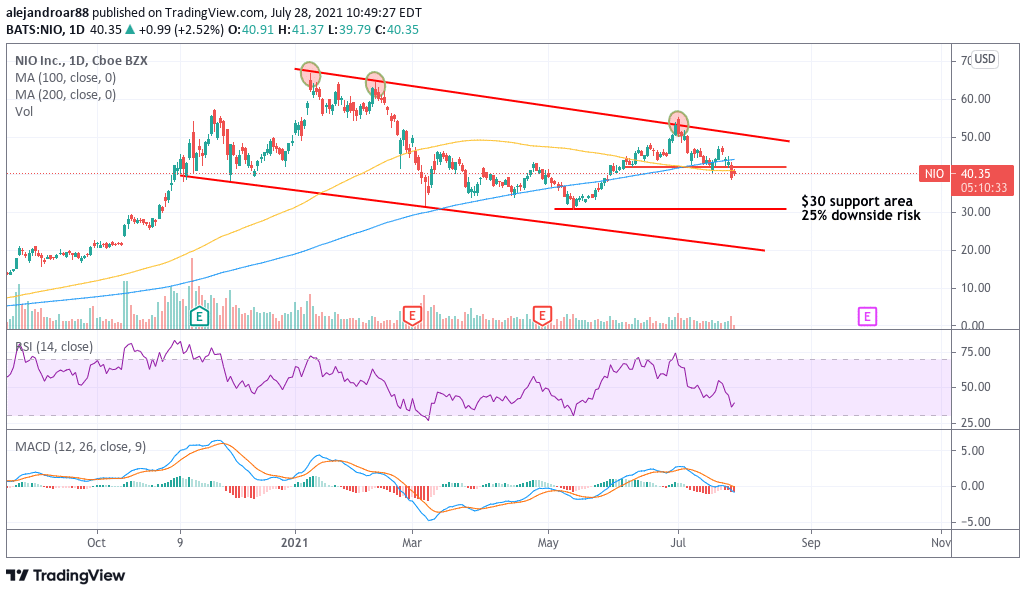Nio Stock Down 26% in July – Time to Buy NIO Stock?
Please note that we are not authorised to provide any investment advice. The content on this page is for information purposes only.
The price of Nio stock is down 26% so far in July as the price action has rejected a move above a long-dated technical resistance while the latest wave of regulatory crackdowns in China is contributing its fair share to the negative momentum seen by the electric vehicle maker stock.
Could the current negative sentiment experienced by Chinese stocks be presenting an opportunity to buy Nio stock at a relatively cheap price? Or is the current weakness poised to continue amid weak fundamentals and overly bearish technical signals?
The following article takes a closer look at Nio’s latest price action while analyzing the current valuation to assess the role that fundamentals are playing in shaping the stock price.
67% of all retail investor accounts lose money when trading CFDs with this provider.
Nio Stock – Technical Analysis

The latest drop in Nio shares in July seems to have taken place after a failed breakout of the trend line resistance shown in the chart above – a rejection that led to a 27% drop from the 1st July highs to this morning’s trading price of $40.3 per share.
Momentum oscillators at the moment have turned bearish as the Relative Strength Index (RSI) is plunging near oversold levels while the MACD has already moved to negative territory.
Meanwhile, trading volumes yesterday were particularly high, almost doubling the 10-day average while they led to a break below what had been a key support area for NIO stock at the $42 level.
At this moment, the stock is trading below its 20-day and 50-day moving averages and has also broken below its long-term 200-day and 100-day moving averages – a situation that emphasizes the strength of the current downtrend.
The outlook for NIO, based on a technical assessment, is bearish unless the price action reclaims the $42 level. Meanwhile, if the downtrend continues, the next support area could be found at the $30 level for a 25% downside risk.
Nio Stock – Fundamental Analysis
Nio’s sales have been growing steadily since the company first reported positive top-line results back in 2018, moving from $748 million back then to $2.4 billion by the end of 2020. Meanwhile, the company managed to finally turn a gross profit on the sale of its vehicles last year, generating $187 million in top-line profitability while it reported total sales of $1.22 billion during the first quarter of 2021 and gross profits of $237 million.
These margins have been improving since the second quarter of 2020 – back when it first reported a positive gross profit – moving from 8.4% back then to 19.5% by Q1 2021.
Vehicle deliveries have been progressively moving higher, from 3,553 units sent back in the second quarter of 2019 to 20,060 units by the end of this first quarter.
The company has also been able to trim its non-GAAP and GAAP losses progressively recently, moving from a net loss of $1.65 billion back in 2020 to negative $812 million by the end of 2020.
However, during the first quarter of this year, losses accelerated to $744 million amid the purchase of an equity interest in Nio China for a total of $671.6 million. Excluding that item, adjusted net losses landed at $54.1 million which results in a 78.6% improvement compared to the figure reported during the same period a year ago.
Apart from the negative momentum prompted by the Chinese government’s latest regulatory actions, Nio’s results have been pointing in the right direction as the company has been increasing its vehicle delivery volumes along with posting higher revenues, positive top-line profit margins, and lower net losses.
In regards to its solvency, the company reported long-term borrowings of $1.75 billion on total assets of $9.32 billion including $4.37 billion in cash and equivalents and $2.84 billion in short-term investments.
At its current market capitalization of $70.7 billion, the firm is trading at almost 13 times its 2021 forecasted sales while the market expects that the firm should continue to post net losses at least until the end of 2022. For that year, non-GAAP earnings per share are expected to land at $0.1 which results in a forward P/E ratio of 400.
Even though the P/S ratio is not necessarily stretched based on Nio’s forecasted revenue growth rates, the valuation as a whole is fairly high considering the risks that the company is facing at the moment amid the government’s increasingly hostile policies toward private businesses.
Investing in Nio in this environment would probably demand a higher margin of safety as there are too many uncertainties that could materially affect the firm’s performance in the future.
Based on these readings and considering the stock’s bearish technical setup, it would be plausible to see Nio shares plunging further in the following weeks.






